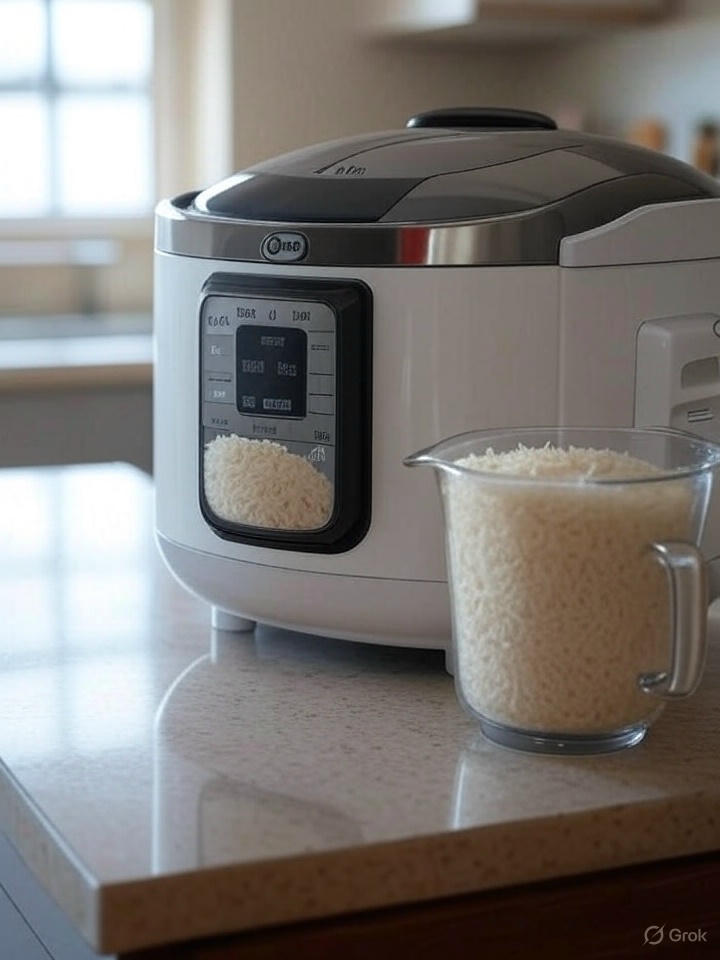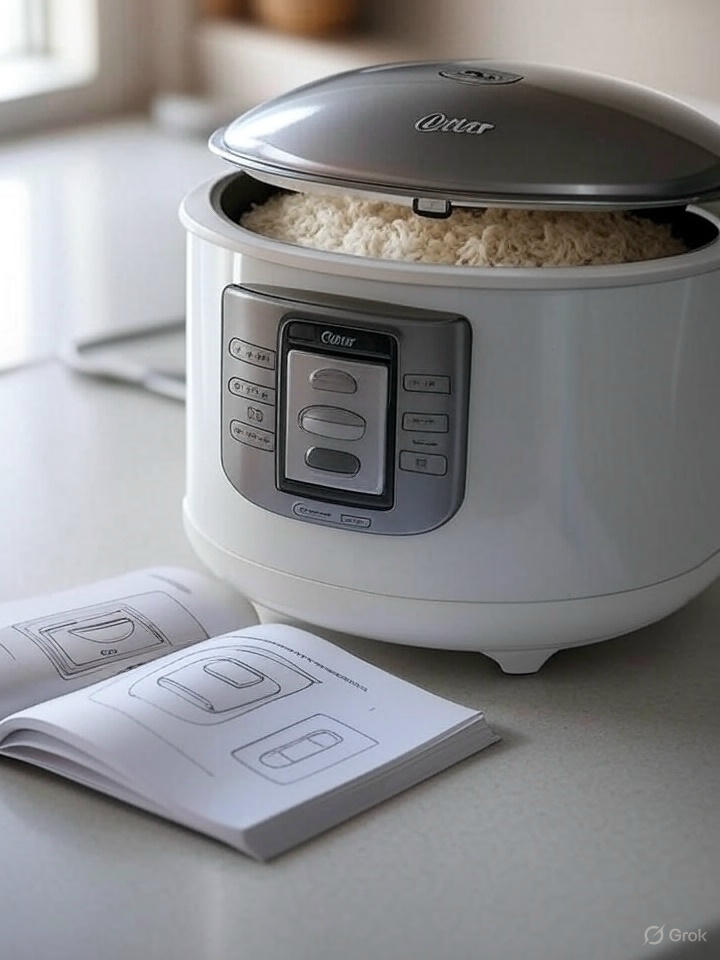Cooking rice perfectly can feel like a kitchen puzzle, but an Oster rice cooker takes the stress out of the process. Whether you’re asking, “How do you use an Oster rice cooker?” or searching for a step-by-step guide to using a rice cooker, this article has you covered. With models like the Oster 6-Cup Rice Cooker and the Oster 20-Cup Digital Rice Cooker, you can whip up fluffy rice for a quick dinner or a big family gathering without breaking a sweat. Below, I’ll walk you through how to use an Oster rice cooker, share the rice-to-water ratio, explain the Oster rice cooker buttons, and throw in tips for steaming and troubleshooting. Let’s get cooking!
Why Choose An Oster Rice Cooker?
Oster rice cookers make rice preparation effortless for both beginners and pros. They use built-in sensors to detect when rice is done, so you don’t need to babysit a pot or set a timer. The Oster 6-Cup Rice Cooker holds 3 cups of uncooked rice, yielding up to 6 cups of cooked rice—great for small families or meal prep. The Oster 20-Cup Digital Rice Cooker is perfect for larger gatherings, handling up to 10 cups of uncooked rice. Both feature nonstick inner pots, automatic keep-warm functions, and one-touch operation for simplicity.

Users rave about the affordability and reliability of Oster rice cookers. The 6-Cup model has a 3.5 out of 5 rating from 49 reviews on Oster’s, with many praising its ease and fluffy results. A reviewer, George07, said their 11-year-old 6-Cup model still delivers perfect rice twice weekly. On Amazon, 335 out of 350 reviews for the 6-Cup model highlight its performance for rice and even lentils, making it a versatile kitchen tool.
How To Use An Oster Rice Cooker: Step-by-Step Guide
Here’s a detailed guide to answer “How do you use a rice cooker step by step?” and ensure perfect rice every time, whether it’s white, brown, jasmine, or basmati.
Step 1: Gather Your Tools and Ingredients
You’ll need:
- Oster rice cooker (6-Cup or 20-Cup model)
- The provided Oster measuring cup (1 Oster cup = ¾ standard US cup)
- Rice (white, brown, jasmine, basmati, or others)
- Water or broth
- A rice paddle or fork for fluffing
- Optional: salt, oil, or butter for flavor
The Oster measuring cup is crucial because it matches the water line markings inside the inner pot. Lost it? Use a standard measuring cup and measure ¾ cup of dry rice per “Oster cup.”

Step 2: Rinse the Rice
Rinsing removes excess starch, preventing sticky or gummy rice and reducing boil-over. Place rice in a fine-mesh strainer or bowl and rinse under cold water until it runs clear, typically 3 to 4 rinses. An Amazon reviewer noted that thorough rinsing stopped their Oster 6-Cup Rice Cooker from bubbling over, especially at full capacity.
Step 3: Measure Rice and Water
The rice-to-water ratio is key for perfect results. Oster provides these ratios for different rice types:
- White rice: 1.5 cups of water per 1 cup of rice
- Brown rice: 2 cups of water per 1 cup of rice
- Jasmine or basmati rice: 1.25 cups of water per 1 cup of rice
For example, to make 6 cups of cooked white rice, measure 3 Oster cups (2.25 standard cups) of uncooked rice and add water to the “3” line in the inner pot. For softer rice, soak it for 15–20 minutes before cooking. For firmer rice, like for fried rice, reduce water slightly (e.g., 1 cup water per 1 cup jasmine rice). Curious about the Oster rice cooker ratio? These ratios are outlined in the Oster rice cooker manual PDF for clarity.
Step 4: Set Up the Rice Cooker
Place the rinsed rice and water in the nonstick inner pot. Ensure the pot sits flush—some users say it feels springy, but the weight of rice and water helps it settle. Close the lid securely, plug in the cooker, and press the “Cook” button (or push down the lever on manual models like the 6-Cup). Wondering which button is Cook on an Oster rice cooker? On the 6-Cup model, it’s the lever you push down; on the 20-Cup model, it’s the labeled “Cook” button. The red “Cook” light turns on, and steam may escape from the vent—that’s normal.
Step 5: Cook and Stir
Oster rice cooker time varies by rice type and quantity. White rice takes about 15–20 minutes, while brown rice needs 30–40 minutes. Around 15 minutes, carefully lift the lid (mind the steam!) and stir with the included paddle to prevent the bottom from overcooking. Close the lid and let it finish. The cooker switches to “Warm” mode when done, with the red light turning yellow. Check the Oster rice cooker manual PDF for specific timings.
Step 6: Rest and Fluff
Let the rice sit in “Warm” mode for 15 minutes to absorb moisture for a fluffier texture. Fluff it with a rice paddle or fork to separate grains. Avoid leaving rice on “Warm” for hours, as users report the bottom can get crusty.
Step 7: Serve and Clean
Scoop out rice with the provided paddle to avoid scratching the nonstick pot. The inner pot is dishwasher-safe, but hand-washing with warm, soapy water preserves the coating. Wipe the exterior with a damp sponge and dry thoroughly.
Tips for Perfect Rice Every Time
Here are 8 practical tips to master your Oster rice cooker:
- Use the Oster Measuring Cup: It ensures accurate measurements. An Amazon user said using a standard cup caused inconsistent results.
- Adjust Water for Texture: Reduce water by ¼ cup for drier rice; add a splash or soak longer for softer rice.
- Rinse Thoroughly: Rinse 3–4 times to prevent boil-over and sticky rice, especially at full capacity.
- Stir Mid-Cooking: A quick stir at 15 minutes prevents scorching, as a reviewer noted for perfect results.
- Try Broth for Flavor: Swap water for broth to enhance taste, as suggested by Taste of Home for jasmine rice in stir-fries.
- Limit Warm Time: Unplug after 15–20 minutes to avoid a crusty bottom, per user feedback.
- Clean Promptly: Wash the inner pot after use to prevent starch buildup. The nonstick coating makes it easy, per Amazon reviews.
- Cook Other Grains: Use brown rice ratios for quinoa, farro, or barley.
How to Use an Oster Rice Cooker as a Steamer
Wondering how to use an Oster rice cooker as a steamer? Models like the Oster 6-Cup Rice Cooker with Steamer include a steaming tray for vegetables, fish, or noodles. To steam:
- Add 1–2 inches of water to the inner pot (no rice).
- Place food in the steamer tray, ensuring it doesn’t touch the water.
- Close the lid, press “Cook,” and steam for 10–20 minutes (e.g., zucchini takes about 10 minutes after heating).
A reviewer loved steaming carrots and broccoli while cooking rice, saving time and dishes. The tray fits 1–2 servings, ideal for small households.
Troubleshooting Common Issues
Here are solutions to 5 common Oster rice cooker problems:
- Rice Burns on the Bottom: Add more water or stir mid-cooking. A user fixed this by increasing water for brown rice.
- Water Boils Over: Rinse thoroughly and avoid overfilling. A reviewer solved boil-over by reducing rice to 2 cups.
- Rice Is Too Sticky: Rinse more or use a 1:1 ratio for jasmine rice.
- Pot Doesn’t Sit Flush: Twist the inner pot into place. Rice and water weight helps, per user tips.
- No “Done” Signal: The 6-Cup model lacks an audible alert, so watch for the “Warm” light.
Oster Rice Cooker Models: 6-Cup vs. 20-Cup
The Oster 6-Cup Rice Cooker is compact (10x9x9 inches), affordable (often under $25), and ideal for singles or small families. Users love its durability—one used it for 12 years! Drawbacks include boil-over at full capacity and no off switch.
The Oster 20-Cup Digital Rice Cooker suits larger households with 5 settings (white rice, brown rice, steam, breakfast, soup) and a delay timer. Its stainless steel design and 20-cup capacity (10 cups uncooked) handle one-pot meals like fondue. Users note it burns rice if left on “Warm” too long.
User Reviews and Insights
The 6-Cup model shines for simplicity. An Amazon reviewer called it “the best product I’ve ever purchased” for sushi rice reliability. CodeeCB said it simplified healthy eating by steaming rice and veggies together. A few (3 out of 49 reviews on Oster’s site) mentioned burning or faulty buttons, but these are rare.
The 20-Cup model excels in versatility. A Best Buy reviewer praised cooking rice and steaming veggies simultaneously. Lily Chan from Rice loved its fondue feature. The lack of an off switch is a common gripe.
Beyond Rice: Creative Uses
Try these 3 ideas with your Oster rice and grain cooker:
- One-Pot Meals: Use the 20-Cup model’s soup or breakfast settings for oatmeal or stews.
- Steamed Proteins: Steam fish or chicken while rice cooks below.
- Fondue: The 20-Cup model melts chocolate or cheese for appetizers.
Maintenance and Durability
Oster rice cookers last. A user reported their 6-Cup model working for 11 years. To maintain:
- Hand-wash the inner pot to preserve the nonstick coating.
- Store dry to prevent mold.
- Contact Oster for parts via their website.
Conclusion
The Oster rice cooker delivers perfect rice for everyone, from busy parents to students. Its simple design, reliable performance, and steaming capabilities make it a kitchen must-have. Rinse rice, measure accurately, and stir mid-cooking for fluffy results. Whether you pick the 6-Cup or 20-Cup model, Oster offers value and consistency.
FAQs
How much rice can the Oster 6-Cup Rice Cooker hold?
It holds 3 Oster cups (2.25 standard cups) of uncooked rice, yielding up to 6 cups of cooked rice.
Can I cook brown rice in an Oster rice cooker?
Use 2 cups of water per 1 cup of brown rice. It takes about 30–40 minutes.
How do I prevent rice from burning in my Oster cooker?
Rinse thoroughly, stir at 15 minutes, and add more water if needed. Unplug after “Warm” mode.
Is the Oster rice cooker dishwasher-safe?
The inner pot is dishwasher-safe, but hand-washing preserves the coating.
Can I use the Oster rice cooker for anything besides rice?
It steams vegetables, fish, and more. The 20-Cup model makes soup, oatmeal, and fondue.